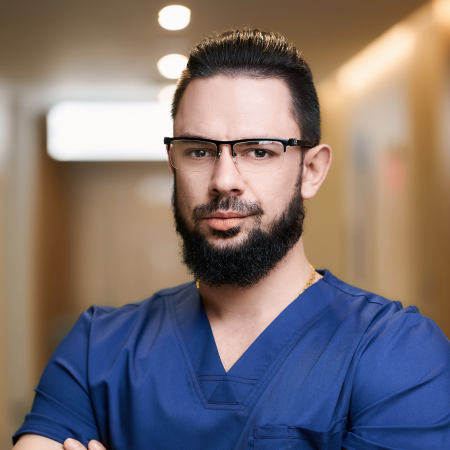Ultrasound examinations
Ultrasound diagnostics (ultrasound) is a widely used, available, harmless, painless and effective method of diagnostics of internal organs using ultrasonic waves (mechanical high-frequency oscillations with short wavelength). Ultrasound can be used to diagnose many diseases as frequently as needed for the precise diagnostics. Ultrasound has barely any contraindications.
Ultrasound allows to:
- assess functioning, dimensions and structure of organs,
- exclude or define the presence of formations, concrements,
- measure the diameter of the vessels, reveal the occurrence of constrictions or dilatations,
- calculate the blood velocity in the vessels.
Apparent advantages of this type of examination are as follows:
- safety;
- informational value;
- ability to diagnose pathologies at the earliest stages of their development;
- possibility to carry out case follow-up of the patient’s condition;
- absence of radiation exposure;
- possibility to carry out diagnostics of children since the first days of their lives;
- possibility to carry out the examinations an unlimited number of times.
Ultrasound types
Ultrasound diagnostics allows to perform the following examinations of children and adults:
- of urinary system;
- of abdominal organs;
- of prostate;
- of vessels;
- of joints;
- ultrasound of pregnancy;
- neurosonography;
- of gastrointestinal tract;
- gynecological ultrasound (female small pelvis organs);
- mammary glands condition (mammographic examination);
- of thyroid and parathyroid glands;
- echocardiography (ultrasound of the heart).
Description of ultrasound procedure
Depending on the organs to be examined, the ultrasound is performed in different ways.
In most cases a patient lies on a couch on the back. Skin in the area of the organ being examined is covered with the conductive gel to improve conductivity of the wave read with a special sensor.
During the examination of kidneys a patient lies on a couch on the side.
If ultrasound is carried out to diagnose female small pelvis organs transvaginally, a patient should strip from the waist down, lay on a couch and spread her legs. For the transvaginal ultrasound the special transducer with the diameter of up to 3 cm is used. For sanitation reasons, a condom is put on the sensing tip covered with the conductive gel.
The data received from the sensor are shown on the special display monitored by an ultrasound specialist. He or she can change the position of the sensor, improving image quality and defining the necessary parameters of the organ under examination: dimensions, boundaries, echoicity and other.
The procedure is absolutely safe and painless and lasts from 5 to 20 minutes.
At the end of the procedure an ultrasound diagnostician issues the medical report on the state of the organ being examined and his or her recommendations.
Indications
Even if a person is completely healthy, routine ultrasound diagnostics is recommended for early detection of possible diseases of insidious nature. Early and timely diagnostics allows to provide timely aid and prevent the transformation of the acute process into the chronic one.
Standard annual screening should obligatorily include the examinations of the following organs: thyroid, kidneys, abdominal organs (pancreatic gland, liver, spleen, gallbladder), mammary glands of women, small pelvis organs of men and women.
Ultrasound examination makes the diagnostics in case of kidney stone disease and cholelithiasis easy. One can define the presence of concrements in an organ, their dimensions, shape and quantity within a few minutes of the examination.
Ultrasound examination procedure is of extreme importance for the patients suffering from hypertonia, stenocardia and other heart and vessel diseases: morphological and functional changes of the heart and the valvular heart apparatus is determined during diagnostics. Besides, dopplerography provides the possibility to define the blood velocity and myocard movement in any point of the heart, which allows to assess the blood flow in case of valvular and congenital diseases. It helps to reveal functional disorders in case of ischemia or cardiomyopathy.
Ultrasound in surgery allows to study a pathologic area for more targeted surgical intervention, to assess the treatment and to prevent the development of complications.
Ultrasound in obstetrics and gynecology is used to reveal abnormalities during pregnancy and intrauterine developmental defects of a fetus.
Contraindications
In most cases ultrasound diagnostics has no serious contraindications, as the method is harmless and can be applied even for the examining of the internal organs condition for pregnant women and small children.
However, there are some relative contraindications, such as:
- skin condition that do not give the possibility to assure the contact of ultrasound sensors with the patient’s body;
- obesity that deteriorates the visualization of data and makes ultrasound less informative;
- urinary incontinence – ultrasound is not recommended if the urinary bladder is to be examined.
Preparation
Ultrasound diagnostics requires some prepping procedures depending on the examined organ location area
- Ultrasound of female small pelvis organs (transabdominal ultrasound)
The examination is carried out with the full urinary bladder. You should drink 1 liter of water (juices and carbonated soft drinks are prohibited) one hour before the examination. You can eat and drink in the examination day, as the examination is not carried out under fasting conditions.
- Ultrasound of female small pelvis organs (transvaginal ultrasound)
Small pelvis organs (uterus, ovaries, uterine tubes) are located deep in the abdominal cavity and are difficult to access with ultrasound examination. To improve the quality of examination, diagnostics is carried out using the special vaginal probe transvaginally. Ultrasound of the small pelvis of the girls that have not yet initiated sexual activity is performed through anterior abdominal wall (transabdominally).
In most cases special preparation for transvaginal examination is not required: you should just empty your urinary bladder before the procedure. You can eat and drink in the examination day, as the examination is not carried out under fasting conditions.
Ultrasound of small pelvis organs can be carried out in any day of period except for the time of period itself. If the diagnosis is not clear or should be clarified, another ultrasound of small pelvis organs should be carried out in a certain day of the period (according to the doctor’s recommendation).
- Ultrasound of mammary glands
Ultrasound of mammary glands is carried out within the first cycle phase, from the 5th till the 14th day from the start of the period. Special preparation is not required. You can eat and drink in the examination day, as the examination is not carried out under fasting conditions.
- Ultrasound of kidneys and adrenal capsules (in upright and in lying position)
It is better to use activated carbon (that reduces aerogenesis in the bowel) 24 hours before the examination (2–4 pills in the evening before the examination and 2–4 pills in the morning) for better visualization, especially for fat people. You can eat and drink in the examination day, as the examination is not carried out under fasting conditions.
- Ultrasound of prostate (transrectal US + urinary bladder + identification of residual urine)
Ultrasound of prostate is carried out through the rectum, that is why a cleansing enema is needed in the evening before the examination and another one in the morning. It is better to use activated carbon (that reduces aerogenesis in the bowel) 24 hours before the examination (2–4 pills in the evening before the examination and 2–4 pills in the morning) for better visualization, especially for fat people.
You should drink 1 liter of water (juices and carbonated soft drinks are prohibited) one hour before the beginning of the procedure. The examination is carried out with the full urinary bladder. You can eat and drink in the examination day, as the examination is not carried out under fasting conditions.
- Ultrasound of abdominal organs (liver, gallbladder, spleen)
Gases and intestinal content can render the checkup of internal organs (liver, pancreatic gland) during the ultrasound examination difficult, that is why the bowel should be prepared.
Exclude gas-forming food (vegetables, fruit, brown bread, juices, carbonated soft drinks, milk and cultured milk foods) from your menu 24 hours (better 2–3 days) before the examination.
It is better to use activated carbon (that reduces aerogenesis in the bowel) 24 hours before the examination (2–4 pills in the evening before the examination and 2–4 pills in the morning) or take 2 caps of Espumisan three times a day 2 or 3 days before the examination, and 4 caps in the day of examination without water for better visualization, especially for fat people.
The examination is carried out only under fasting conditions (you should not eat or drink anything). The period of time between the last meal and the beginning of the procedure should be not less than 6 hours.
- Ultrasound of urinary bladder
You should drink 1 liter of water (juices and carbonated soft drinks are prohibited) 1 hour before the examination. The examination is carried out with the full urinary bladder. You can eat and drink in the examination day, as the examination is not carried out under fasting conditions.




